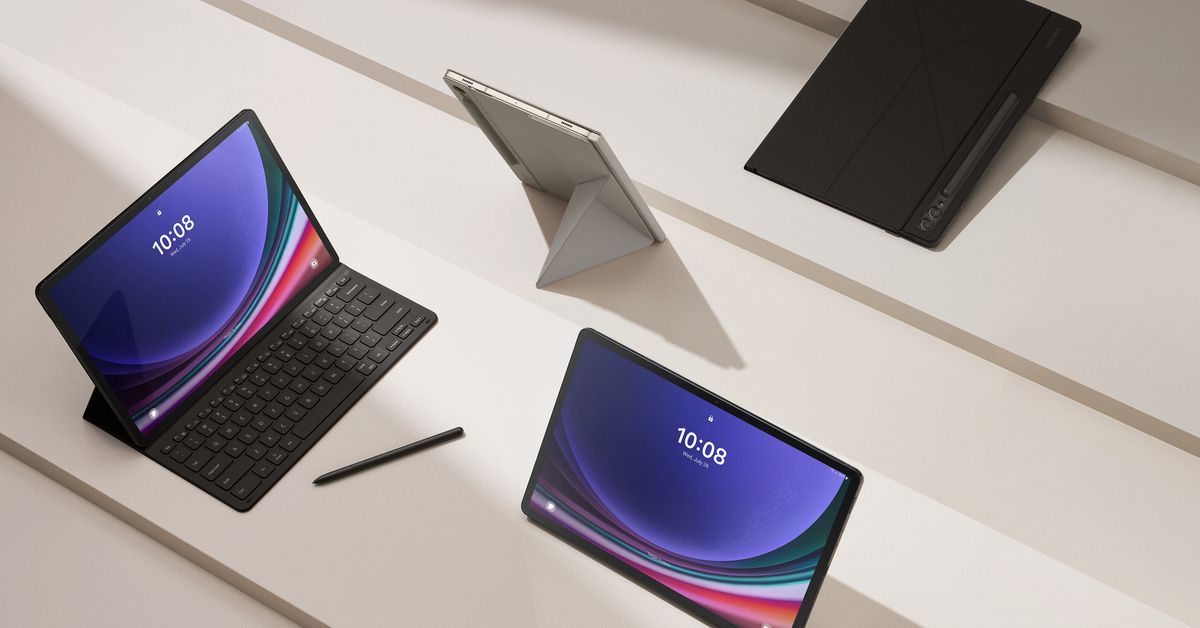Samsung goes OLED all the way with the Galaxy Tab S9 tablets
Samsung has announced its latest high-end Android tablets: the new Galaxy Tab S9, S9 Plus, and S9 Ultra. The new models follow the Tab S8 series from 2022, with similar designs and features. As before, the smallest Tab S9 starts at $799.99, while the two larger models are $999.99 and $1,199.99, respectively. All of the tablets are available for preorder starting today, July 26th, and are slated to ship starting on August 11th.
What is different is the environment. Samsung has effectively had free reign of the high-end Android tablet market (or whatever scraps Apple’s iPad leaves behind) for the last decade or so. But this year, there are a surprising number of other options from companies like Google, OnePlus, and Lenovo, all bringing different ideas of what a tablet can be — often at a lower price than Samsung offers.
Despite that new competition, the Tab S9 lineup effectively looks the same as before, but with updated processors and newer software (that will likely come to the older models via updates this year). The flagship tablets are still leaning into productivity, with software that supports multitasking and other power user features. They can also be equipped with optional keyboard cases that make them pseudo-laptops.
The Tab S9 tablets all come with Samsung’s S Pen stylus in the box. Image: Samsung
One notable change is Samsung is using OLED screens across the lineup now, as opposed to reserving them for the largest models. All three tablets have screens that can refresh up to 120Hz for smooth scrolling and lower pen latency. The sizes remain the same: 11 inches on the Tab S9, 12.4 inches on the Tab S9 Plus, and a gargantuan 14.6 inches on the Tab S9 Ultra. Sadly, Samsung is sticking with 16:10 aspect ratios across the board, which means these tablets will work best in landscape mode and will be more awkward for reading and other portrait-orientation use cases than an iPad or the OnePlus Pad.
Additionally, Samsung has made the Tab S9 tablets IP68-rated for dust and water resistance, a first for the lineup and matching what it offers on its top-tier smartphones. Water and dust resistance of any sort is rare for tablets; between the OLED screens and IP rating, Samsung is justifying its premium price and differentiating itself from most other Android tablets and even the iPad, at least a tiny bit.
All three Tab S9 models have IP68 water and dust resistance
All three Tab S9 models are powered by the Snapdragon 8 Gen 2 for Galaxy, the Samsung-exclusive version of Qualcomm’s top-tier processor. The base model of the 11-inch S9 comes with 8GB of RAM; the rest of the lineup has 12GB, save for the top-level S9 Ultra that comes with 16GB. Storage options for the Tab S9 are 128GB or 256GB; the Tab S9 Plus comes with either 256GB or 512GB storage, and the Ultra can be equipped with up to 1TB of onboard space. All three retain the ability to expand their storage via microSD cards, another differentiator from the iPad and most other Android tablets these days.
Samsung says only the Tab S9 Plus will be available with 5G connectivity, though it’s likely that exact availability will depend on your carrier and country. All three models support Wi-Fi 6E for the latest home network speeds.
Rounding out the hardware features are the S Pen stylus (still included in the box), a quad-speaker system (20 percent larger than before) with Dolby Atmos, and in-screen fingerprint scanners. The tablets come in either beige or graphite gray, and you’ll still have to bring your own charging brick.
The Tab S9 Ultra’s 14.6-inch display makes it more akin to a laptop in size than a tablet you can hold in your hand. Image: Samsung
If you are looking for a more advanced writing or drawing experience, Samsung’s new optional S Pen Creator Edition provides a larger size, textured grip, and a wider tilt angle. It also has the ability to swap between a softer or firmer tip.
Samsung’s software provides more options for productivity and multitasking than what’s available on the Google Pixel Tablet or the OnePlus Pad. It allows you to run up to three apps at the same time in a split-screen setup or switch to a full desktop environment with the Dex feature. Samsung has been slowly iterating on these features over the years, and the result is it’s much easier to get work done on its tablets than others, especially if you rely on using multiple app windows at the same time. A new feature called Multi Control also lets Samsung tablet users copy and paste or drag images to a compatible Samsung phone wirelessly.
Source: The Verge


